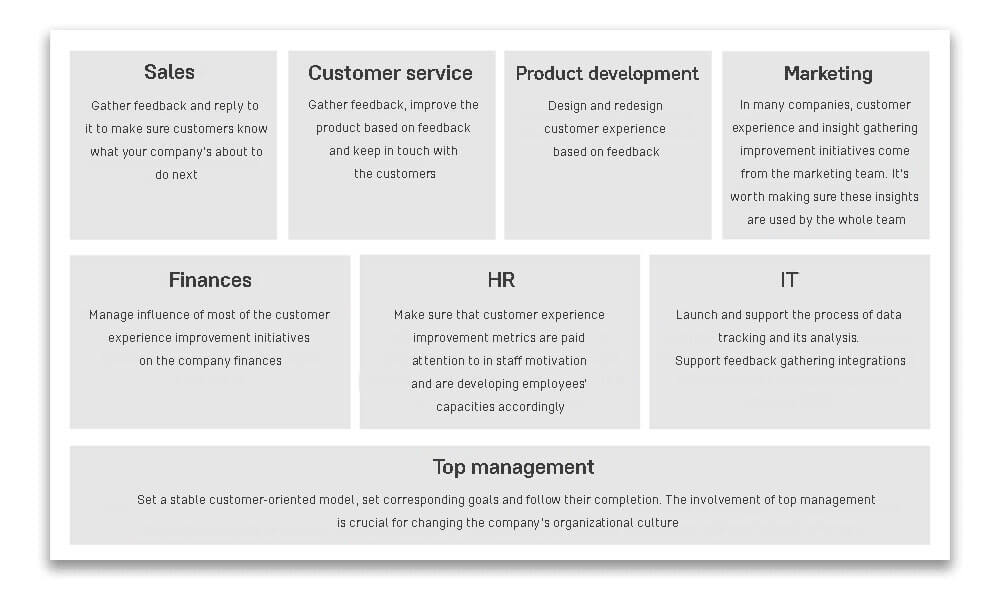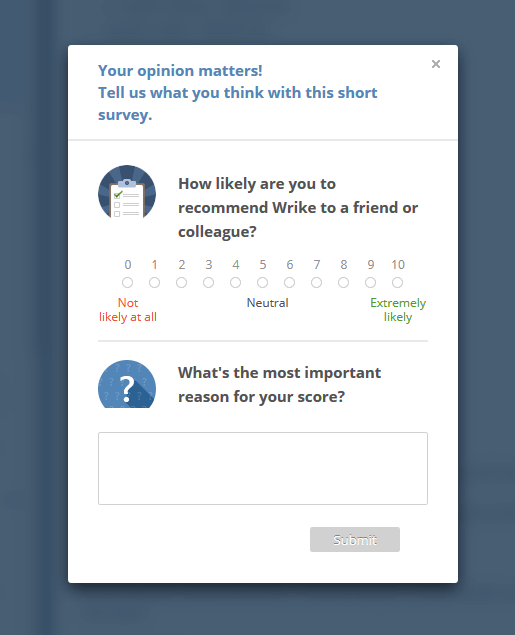Customer Experience Management

Dividing your customers and conquering their emotions may sound like a sinister plan for world domination, but it isn’t. Today, we’re talking about customer experience management, and for that you won’t need any sinister tendencies at all.
If we’re being serious here, a thoughtfully planned customer experience management system can increase your customer satisfaction and loyalty, decrease churn and raise your business’s revenue. Sounds cool, doesn’t it?
What is customer experience?
Let’s start from the beginning.
Customer experience represents all of the interactions between a client and a company. This process includes discovering the company, implementing best customer engagement strategies to contact it, initially interacting with it, billing, and using and protecting the brand.
Every step of customer experience influences the customer’s loyalty and how actively they interact with the company.

For instance, if you make your customers happy by exceeding their expectations — for example, making deliveries earlier than expected or providing personalized content — they’ll be more likely to share their gratefulness and excitement with the broader community.
Read also:
👉 How to use lead generation chatbot for your website
👉Lead nurturing platform for your revenue growth
👉 12 types of marketing nurture campaigns
What factors shape customer experience?
User experience and customer service are two components of customer experience. User experience is about interacting with visitors to your website and users of your software, while customer service is support that organizations provide their customers when they face problems with any of the aforementioned.

Therefore, customer experience management is a strategy aimed at enhancing a customer’s impression at all levels of interaction with your company.
Why is customer experience management important?
Less words, more data. Take a look at the statistics:
- According to research by Oracle, 74% of high-level managers are certain that customer experience influences how actively buyers turn into brand advocates.
- A study by American Express showed that 60% of its participants were willing to pay extra for a better customer experience.
- 80% of the companies that participated in a study by Bain & Company consider their customer experience perfect, while only 8% of their customers agreed.
The right customer experience strategy can help you win the hearts of your customers and leave the image of your brand lingering in their minds.
Read also:
- Attract customers with these 24 ecommerce lead magnets
- The 7 Key Email Marketing Metrics & KPIs You Should Be Tracking
- Product adoption: 7 tips to prove your value
Customer experience management — whose area of responsibility is it?
Who is responsible for customer experience in your company? That role, of course, can be assigned to a separate customer experience management team or top-level management, even an accountant — anyone, really, but in reality, all of the teams must work together to shape customer experience.
Customer experience management isn’t just the job of one team, it’s everyone’s deal.

This chart shows how roles are usually distributed in a company. Successful companies make use of all of their employees when managing customer experience. Can you say the same thing about your company? Actively involving your whole team in customer experience management is a necessity, not just an option.
Read also: What customer engagement platform is best for your business? 15 options to choose.
Three metrics of customer experience management
Let’s get down to business and take a look at the metrics that will show how your customer experience management is doing. Here are the three largest players customer experience management analytics: Net Promoter Score (NPS), Customer Satisfaction Score (CSAT) and Customer Effort Score (CES).
Net Promoter Score (NPS)
NPS is a quick and easy way to rate your customers’ loyalty. NPS surveys don’t take much time: usually such a customer engagement strategy just contains one question like “How likely are you to recommend our company to your friends and acquaintances?” The question is followed by a scale from 1 to 10 and a comment field.

Here’s one more pro: NPS survey results are easy to gather and analyze within different segments to understand well what segments of customer experience you’re good at and what segments require some more work from you.
How to count NPS:

Customer Satisfaction Score (CSAT)
CSAT is another easy and effective way to learn from your users about how much you satisfy them at any step of their interaction with you. CSAT surveys are typically used after a user makes a transaction or contacts your technical support. Here’s what a conversation rating looks like in Dashly, for instance:

How to count CSAT:
If your rating tool doesn’t have such a function, assign a score to each response, sum every rating and then divide it by the number of users.
Read more
- 10 Best Live Chat Software for Customer Support
- 10 Best Customer Service Chatbot Platforms to Level Up the Work
- How to create a user journey online map for your online school students [4 free templates]
- Increase Customer Support Efficiency With 15 Best Knowledge Base Tools
- Chatbot Guide: What can a chatbot do for your customers 24/7
Customer Effort Score (CES)
Another popular customer experience-related metric is Customer Effort Score (CES). Customer Effort Score may appear similar in form to Customer Satisfaction Score, but it targets another goal: to see how easy it was for your user to do this or that in your service. , For example, within SaaS segment it depends on the quality of your client onboarding.

Generally, the easier it is for a user to solve their problem using your service, the better their customer experience is. CES is a metric that can help you see the factors that may make users stop using your service.
Comparing the results of all three metrics can show you the complete picture of customer experience in your service, with all of its strong and weak sides, which also means that it will be easier for you to make improvements, since you’ll see what has to be improved first. However, each of these metrics can prove useful on its own.
Each of these methods doesn’t include capturing leads. If. you want to conduct interviews with your clients on the issue — add a relevant field to your survey. Btw, here is the best way to collect emails Dashly clients use.
Read also:
⭐ Sales Funnel Emails in 2025: How to Build a High-Converting System [11 Examples Inside]
⭐ How to Identify and Fix a Leaky Sales Funnel: 6 Smart Strategies
Customer experience management: Course of action
To be completely satisfied with your customer experience management, it’s important to take the right course of action, which may include the following steps:
- Finding weak spots in customer experience using metrics
You may be thinking that you’re doing everything absolutely correctly, and that just mentioning the name of your brand makes your customers happy. We are genuinely glad for you if that’s how it really is, but just in case, check the metrics so you don’t have to face the cruel reality of a high customer churn.
- Involving success managers in the process
After you’ve found your weak spots, you can involve professional success managers in the process. They are the people most interested in your customers’ success, and involving them is very likely to improve your customer experience.
- Improving your product with your customers’ feedback in mind
If a major amount of your customers get stuck at a particular point then it’s a bad signal: something is wrong with your product, not with your customers. Metrics and feedback can show you the right way to further improve your product. Use chatbot platform to collect customer feedback and evaluate the results on autopilot.
- Improving LTV metrics, lowering churn metrics
Aside from the metrics we’ve mentioned before, there are two more that are crucial for any business. Customer experience partly influences them too, and the better your customer experience management strategy is, the better the LTV metrics and the lower the chances of your customer refusing to continue using your product because of its imperfections.
Read also: Capture emails from website visitors with Pop-ups
How to develop a customer experience management strategy: The best practices
If your customer experience is problematic, then of course you can start running in circles and tearing your hair out, but it’s better to start working on a strategy, and make sure all of your actions are coordinated and are leading to the results you need.
The most popular approach to building a customer experience management strategy consists of the following steps:

Step 1: Needs estimation and customer segmentation
This step should give you a clear understanding of what your customers need, what motivates them, what their goals are, and what they need from your product. Compare it to your customer segmentation and you’ll find it easier to understand your customers and manage their experience in a more thoughtful and personalized way.
For a basis, you can use:
- Customer portrait: All of the known facts about your average customer, such as their location, the size of their company, and its direction;
- Behavioral characteristics: What your customers buy, when and where they trade and so on;
- Needs: What your customers need, how they solve their problems, and what makes them tick.
The latter is the most important one for building a strategy, and it demands that you deeply study your customers.
Read also: how to find respondents for a survey or customer interview
Step 2: Customer experience map
On this step, you’ll need to make a detailed customer experience map for each segment. It’s important to study every segment separately, as their customer journeys may differ from each other. A customer experience map will help you look at the contact points between your customer and your service from the moment you meet them to the point when they become your active users (or, in the worst case scenario, to the point when they stop using your service).
What tool to use? User tracking on website will help you define what pages clients visit, what buttons they click and don’t.
Step 3: Determining the desired experience
Use your customer experience maps to develop a model of the perfect customer experience and then compare it to how things are really going. Based on that information, think about what can be improved to make working with your service nice and easy and what can be done to make your customer experience excellent.
Read also: The North Star Metric and How Can This Lead to Success
Step 4: Creating a brand experience
On this step, it’s important to understand the feelings and emotions that your customers experience when working with your brand.
To make your brand experience positive, it’s important to take note of the identity and value of your brand. These commonly take the form of “promises” that lay the cornerstone of the customer experience and form customers’ expectations when working with your service. Generate a brand experience based on positive emotions that will bring you closer to your customers. The most important thing is not to forget what kind of people use your service, what their experience and background are, and how they really perceive your brand.
Step 5: Structuring contact points with your clients and improving interactions
Structure contact points so that interacting with your customers in each of them works towards building a great customer experience, evokes positive emotions from working with your brand, and increases loyalty. Analyze working processes on each step, focusing on how good they are with translating your value and usefulness to the customer.
| Contact | takes notice of an online or offline advertisement notices a company post on a social network news feed recognizes the company logo at a conference reads press releases, annual reports, or blog articles receives and reads emails |
| Interaction | comments on company posts on social networks chats with the customer support team talks with a company representative at a business conference shares a company article or a post on a social network visits the company website |
| Involvement | signs up for a trial or freemium registers for a webinar |
Read also: Find out the best Intercom alternatives and Drift alternative for your support team
Step 6: Analytics and improvement
Finally, the circle is completed when you measure the effectiveness of your customer experience management. We’ve already mentioned the metrics that can help you evaluate how productive your customer experience management is. Now, take a look at some different approaches to measure customer experience directly:
- Periodically survey general customer satisfaction — take a deep dive into the experience of specific customers.
- Give surveys about specific events right after they’re completed.
- Regularly survey randomly selected customers; evaluate their brand perception and reveal key metrics.
This information will prove useful for improving customer experience for certain customers (especially important for B2B), groups of customers (your most valuable segments), or all of your customers in general.
That’s all for now. We don’t want to bother you with lengthy farewells; you’ve got great customer experience management deeds ahead of you!
Read also:
- Customer VS Client — making the difference clear
- Why eCommerce and omnichannel are inseparable?
- How to qualify lead within sales and marketing teams
- Ultimate guide to inbound lead qualification in EdTech marketing
- How to Qualify and Collect More Leads with Lead Bot?
- How BANT sales process can help you get qualified SQL in 2022



![12 Mistakes When Choosing Live Chat, Users Regret About [Based On Capterra Reviews]](https://www.dashly.io/blog/wp-content/uploads/2021/03/live-chat-mistakes-720x308.jpg)



